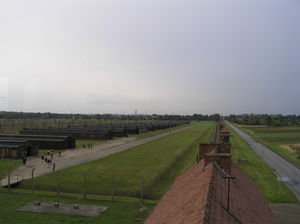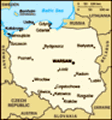Advertisement
Published: October 17th 2007

 Birkenau
Birkenau
The magnitude of it was incredibleNext destination - Krakow.
Clearly not a destination you head for a bit of fun, but on our very first day we set off for Auschwitz-Birkenau. We decided to go on a tour to soak up maximum information. Just to insure that you knew what you were getting yourself into, the start of the tour was a 50 minute video (shown on the bus) about the atrocities at Auschwitz. Some of it was very graphic and it set the mood and definitely reminded everyone that it was not going to be an ordinary kind of tour.
A lot of the information we heard on our tour was the same as that we heard in Berlin, however, being in the place it happened made it feel that much more real. The most moving part of the experience was walking around the buildings (particularly in Birkenau where the buildings are still as they were to show living arrangements), seeing where and how people lived and envisaging their lives during their incarceration. The people at Birkenau were housed in old stables in massive triple high bunks, about 6 to a bed. Other stables were designed as bathrooms. There was a long concrete

 Birkenau
Birkenau
And many of the parts have been destroyedlatrine down the middle and everyone was required to go to the bathroom together. It was extremely unhygienic. Overall though, the most shocking thing for us was the scale of the Nazi plan. The number of buildings and the number of people those buildings saw to their death was extremely shocking.
One of the most shocking exhibits in the museum buildings were the rooms full of prisoners' belongings. On arrival at Auschwitz all of the prisoners were asked to pile up their belongings and then they were carted off to storage sheds never to be seen by their owners again. The reason why the prisoners brought so much with them is that many of them came to Auschwitz voluntarily. Some even bought tickets for the train! They believed that they were being resettled so brought all their valuables to enable them to start a new life.
After their belongings were taken from them, the prisoners went through the second phase - selection. The concentration camp doctor would determine who was fit for work and who was not. Those who were not fit were sent straight to the crematoriums. They were told they were going to have showers to

 Birkenau
Birkenau
The station where new prisoners arriveddisinfect them and prevent illnesses from spreading. In the first room they undressed completely. They were told to remember the number of the peg on which they hung their clothes so they could more easily collect them after their shower. Only, as we know, they were never going to have that chance. The next room appeared to have shower heads hanging from the ceiling, but instead of water, pellets of poison were dropped from holes in the ceiling releasing a deadly gas which killed everyone within 20 minutes. Then the grave robbers came in. We were told that the Nazis did not want to waste anything so, in an early shocking example of recycling, all valuables were removed, including gold teeth, and were sold off.
Perhaps the most shocking exhibit was the collection of another item of value - human hair. All of the women had their hair cut and it was sold off for making textiles. There is a whole room full of hair - all gray and matted together. People have even found materials which have been tested and positively proved to have been made partly from human hair. Other rooms were full of spectacles, suitcases, clothes,

 Auschwitz
Auschwitz
The entrance gates with that famous quote "Work brings freedom".prosthetic limbs and other items.
We didn't really take many photos at Auschwitz or Birkenau - it just didn't feel right. Our memories of that place are sufficient enough. What really got to us, and which we mentioned before, is that so many of these people thought they were coming to a better life. Even when they realised it wasn't what they thought (those that survived the initial selection phase), they still didn't give up hope. One reason for this is that over the entrance gate was a sign in German which translates roughly to "Work brings freedom". Therefore, they thought that if they worked hard that eventually they may earn their freedom. But 12 hour or more working days with no proper food or sufficient water, and poor clothing, sleeping and sanitary arrangements killed most of them before the end of the war. Those who did survive were no doubt huanted for their rest of their life by their time at Auschwitz.
Not something we can say we enjoyed, but we are definitely richer for the experience. As many wise men and women have said, it is important to remember these atrocities in the hope that nothing
like it will be perpetuated again. Unfortunately, it doesn't seem to have worked yet, as our recent experience in Rwanda showed us.
On a lighter note, we spent a much more enjoyable day the following day at the Salt Mines. It was totally amazing. An underground salt mine is a completely foreign concept for us, given we are used to the open air above ground style of salt mining we see up north. The salt is mined in blocks and then lifted to the surface. The mine goes to a depth of about 300m, but we only went down as far as about 130m. But given the lift experience on the way up (9 people jammed in a space about 3 foot by 4 foot!), we were quite happy it wasn't any longer.
Aside from simply being in the mine, what makes it really interesting is that the miners created an underground world down there. The miners pretty much had to live down in the mines so one of the first things that they built were in-house chapels. They were carved out of the salt and so were the decorations around them. One of the chapels is huge
and is still used for regular Sunday services, weddings and other special events. Even the ex-Pope has been down there!
There is also a heap of monuments which show the history of the mine. Particularly interesting was that they used to have horses underground. Many of these horses never saw daylight. The last horse was removed from the mine only 5 years ago. Sounds cruel but apparently these horses lived longer than those on the surface due to the conditions in the mine, as the mine air is full of essential minerals. In fact, it is so healthy for you that the mine now contains 2 "health spas" (or rehabilitation centres as they call it) where people can go to relax and rejuvenate. Definitely not our cup of tea. Happy enough to know that because we visited the mine we should live 3 days longer than a person who hasn't visited the mine.
Advertisement
Tot: 0.122s; Tpl: 0.017s; cc: 11; qc: 53; dbt: 0.0501s; 1; m:domysql w:travelblog (10.17.0.13); sld: 2;
; mem: 1.2mb















